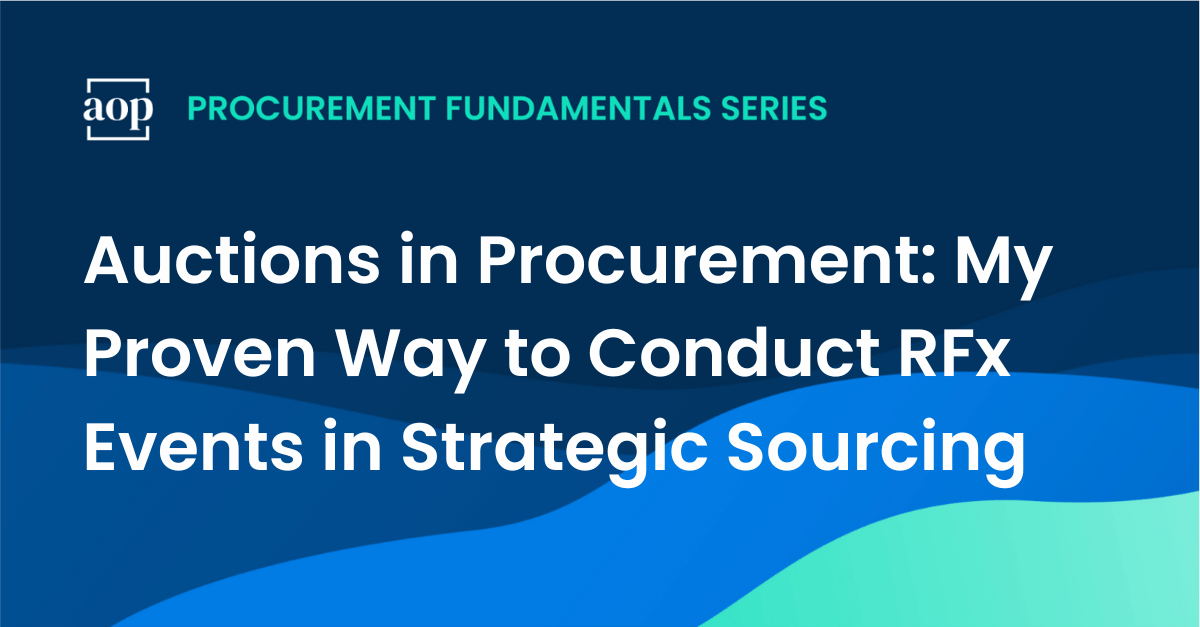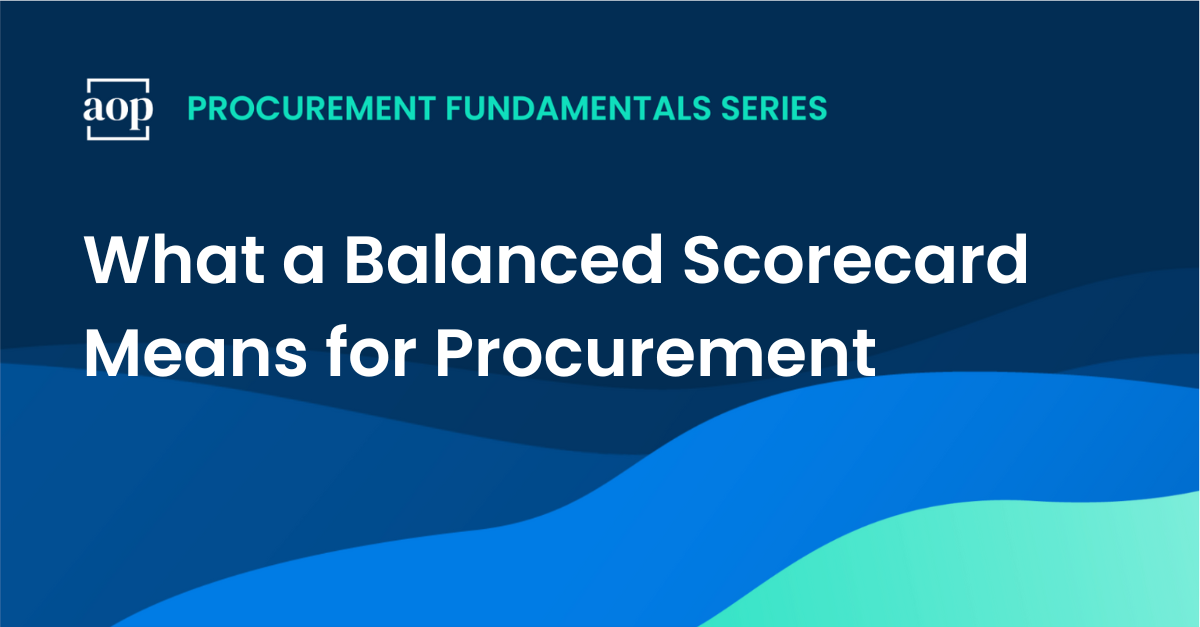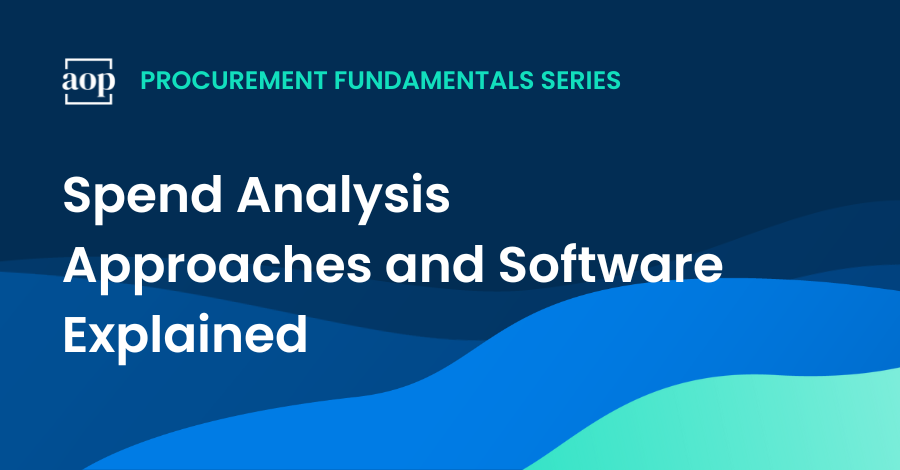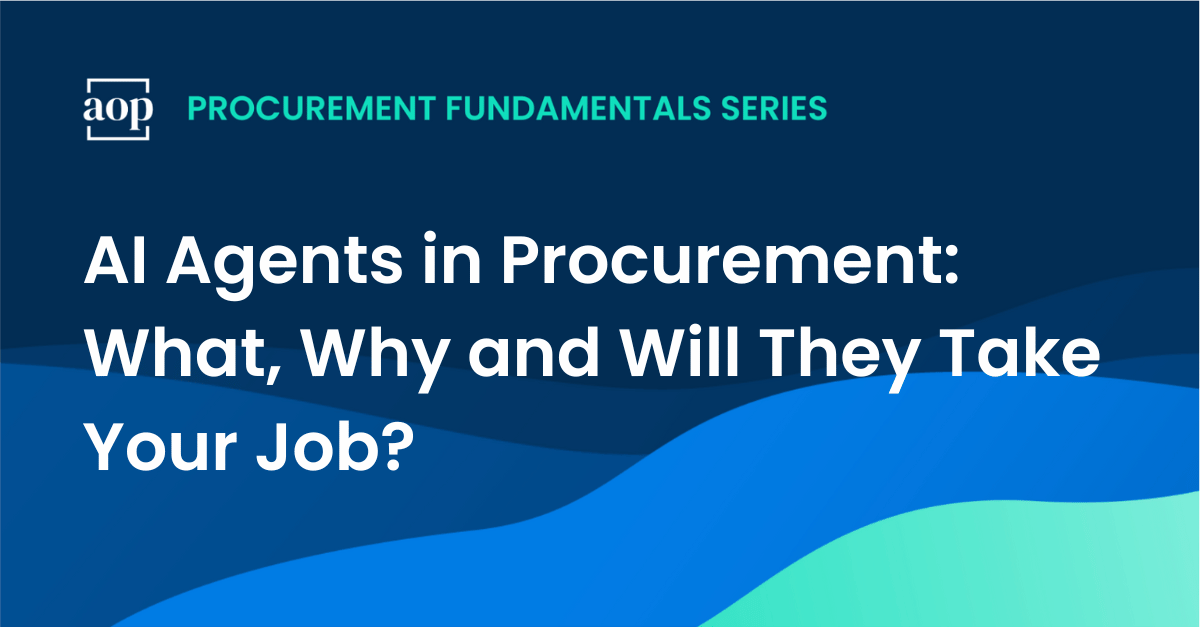9 min read
Auctions in Procurement: My Proven Way to Conduct RFx Events in Strategic Sourcing
Philip Ideson : April 1, 2025

Auctions and RFx events are two of the most powerful tools in a strategic sourcing toolkit. When executed correctly, they don’t just drive competitive pricing—they attract high-quality suppliers, sharpen competition, and ensure your sourcing efforts deliver maximum value.
Over the years, I’ve conducted countless RFx and auction initiatives as both a procurement practitioner and consultant. Through my practical experience, I developed a structured, repeatable approach for integrating these tools into a broader strategic sourcing framework. Auctions and RFxs shouldn’t happen in isolation—they need to be aligned with your sourcing strategy to create real impact.
Let’s go through my proven approach and key best practices and mistakes to avoid.
How auctions and RFxs fit in the strategic sourcing process
Too many procurement teams issue RFxs without a clear strategy or avoid auctions altogether, missing key opportunities to drive value beyond cost savings. That’s why Step 5 of my 7 Step Strategic Sourcing Process is a pivotal moment—this is where strategy turns into action.

Done right, RFxs and auctions sharpen competition, lower costs, and mitigate supplier risk. Done poorly, they create unnecessary complexity, limit supplier engagement, and slow down the sourcing process.
How to conduct auctions and RFxs in eight steps
You can follow my proven eight-step process to ensure your auctions and RFxs drive strategic value. To maximize success, you need a well-planned approach that encourages competition, ensures transparency, and minimizes risk.
Step 1. Develop a clear supplier communication plan
Before issuing an RFx, establish a structured communication plan that outlines key timelines, evaluation criteria, process steps, and points of contact. Suppliers should understand exactly how the process works and what is expected of them. A lack of clarity can lead to lower participation rates and weaker proposals. Transparent communication builds trust and ensures suppliers put forward their best possible bids.
Pro tip: This communication plan should also be shared with the business. All communications about the RFx should pass through procurement in order to maintain a bias-free process and a level playing field for all interested parties.
Step 2. Develop and issue RFx documents
A well-structured RFx (RFI, RFP, RFQ) is the foundation of a successful sourcing event. Whether you're issuing a request for information, request for proposal, or request for quotation, your documents should clearly define:
- The scope of work, specifications, and requirements
- The evaluation criteria suppliers will be scored against
- Key contract terms and service-level expectations
- Supplier risk assessment questions, including financial stability, information security, and compliance requirements
If you are considering a single-source approach, ensure that a detailed risk assessment and supplier onboarding plan are included in the RFx process.
When to use reverse auctions
Reverse auctions can be a powerful tool, but they are not suitable for every sourcing event. They work best when:
- The product or service is highly commoditized and specifications are well-defined
- There is a competitive supplier market with multiple suppliers capable of delivering the same product or service
- Price is a primary decision factor, and total cost of ownership (TCO) considerations are minimal
Reverse auctions may be less effective for complex or strategic purchases where service quality, innovation, or supplier partnerships play a significant role.
Step 3. Facilitate supplier Q&A
After issuing the RFx, create a structured Q&A process where suppliers can seek clarification on requirements. Ensure that answers to supplier questions are as clear as possible and shared with all potential participants. This will improve bid and proposal quality and prevent misunderstandings that could delay the process. Remember, a well-managed Q&A session also demonstrates professionalism and strengthens supplier confidence in your procurement team and company.
Step 4. Evaluate responses and assign supplier risk ratings
Once supplier proposals are submitted, evaluations should be conducted using a structured approach. Weighted scoring models help quantify supplier capabilities, but they must be designed carefully to ensure fairness. Common mistakes in scoring include:
- Building scoring models in isolation without stakeholder input
- Assigning excessive weight to cost while neglecting strategic factors like service, innovation, or risk
- Allowing group scoring sessions that introduce bias through peer pressure
The most effective approach is to ensure scoring is done independently before discussions occur. This minimizes subjective influence and allows for a more objective supplier selection process.
Step 5. Shortlist suppliers and refine competitive selection
Once initial evaluations are complete, narrow down the top-performing suppliers for further assessment. Shortlisting allows your team to focus on the most viable options without wasting the resources of suppliers that don’t meet critical requirements. However, shortlisting should not be based solely on scoring models—this is where a nuanced approach is necessary.
A common mistake procurement teams make is relying too heavily on raw scores without considering broader strategic factors. Sometimes the top-scoring supplier isn’t the best choice. If your selection process consistently leads to a different supplier than the highest-ranked one, your scoring model may not reflect the true priorities of the business. This is a signal that your weighting or evaluation framework needs adjustment.
Another key step is to engage with internal stakeholders before finalizing shortlists. Procurement should act as a facilitator rather than a sole decision-maker, ensuring that the suppliers moving forward align with operational and business objectives. Misalignment at this stage can lead to last-minute disruptions, stakeholder resistance, or a contract that fails to deliver intended value. Worse still, it could result in procurement having to go back to a supplier that was not shortlisted and bringing them back into the process with more leverage than they had before.
Step 6. Determine and execute competitive next steps
At this stage, you will decide how to proceed with the shortlisted suppliers. There are several potential next steps depending on the nature of the procurement event:
- Final negotiations – If the competition is strong but pricing or contract terms require refinement, move into rounds of negotiation with the top candidates.
- A second-round RFx – In cases where supplier proposals are too close to call or lack differentiation, a refined RFx with updated requirements may be necessary.
- Reverse auction (when applicable) – If multiple shortlisted suppliers offer highly comparable solutions, a reverse auction can drive final price improvements. However, as discussed earlier, this only applies when specifications are standardized, and competition is strong enough to make an auction format effective.
Each decision should be based on achieving the best balance between cost, risk, and value—not just securing the lowest price.
Step 7. Conduct due diligence
Before finalizing supplier selection, conduct a thorough due diligence process to verify supplier claims. Procurement teams often make the mistake of assuming that the proposals they receive are fully accurate, but this is where financial, operational, and compliance checks become critical. Key due diligence steps include:
- Financial health assessment – Reviewing financial statements, credit ratings, and past performance data to ensure the supplier is stable and capable of long-term delivery.
- Operational capacity verification – Site visits, quality audits, and reference checks to confirm the supplier can meet the promised service levels.
- Regulatory and compliance checks – Ensuring the supplier adheres to industry standards, legal requirements, and risk management policies.
Skipping due diligence can lead to the selection of a supplier that looks strong on paper but lacks the ability to deliver consistently. This step protects against supplier failure, disruptions, or hidden risks that could impact your organization down the line.
Step 8. Assign an overall risk rating
Finally, each shortlisted supplier should receive a comprehensive risk rating that factors in:
- Financial risk (likelihood of financial instability or failure)
- Operational risk (ability to meet performance requirements)
- Compliance risk (adherence to regulatory and ethical standards)
- Strategic risk (long-term fit with company goals and market trends)
This holistic evaluation ensures procurement teams don’t make decisions based on price alone, but rather on the full spectrum of factors that impact supplier performance and long-term value.
By following this structured approach, you create a fair, competitive, and transparent RFx and auction process that attracts high-quality suppliers and delivers long-term procurement success.
Best practices to attract high-quality suppliers to your auctions and RFx
Now that you understand the essential mechanics behind conducting successful RFxs and auctions, I want to share the best practices I've refined over many years.
Provide clear, detailed requirements—or an invitation to innovate!
One of the most common frustrations suppliers face is vague or incomplete RFx documentation. When requirements are unclear, suppliers either withdraw or submit overly cautious bids with built-in risk premiums. To attract the best responses, ensure that your RFx documents clearly define the scope, deliverables, and evaluation criteria.
However, if your sourcing strategy requires supplier-driven innovation, consider making space for creative proposals. Instead of rigid specifications, frame the RFx around a business problem or opportunity and invite suppliers to propose unique solutions. This is particularly valuable in categories such as technology, marketing, and professional services, where flexibility can drive innovation and better long-term outcomes.
Ensure transparency at every step
Transparency builds trust with suppliers and ensures a competitive yet fair process. From the moment you issue the RFx, clearly communicate:
- How suppliers will be evaluated
- Key milestones and deadlines
- Any changes or updates to the process
- Post-RFx feedback opportunities for suppliers who do not win
Lack of transparency can discourage participation and lead to weaker competition. Suppliers invest significant time and resources into responding to RFx events, and they are more likely to engage fully if they believe the process is fair and professionally managed.
Establish fair and balanced evaluation criteria
Scoring criteria should align with your organization’s priorities and be structured in a way that allows suppliers to compete on equal footing. A common mistake is assigning too much weight to cost while overlooking factors such as quality, service levels, and innovation. Weighted scoring should reflect a total cost of ownership approach rather than focusing solely on upfront price.
Additionally, scoring should not be done by procurement alone. Work with stakeholders to define what matters most. If stakeholders value service quality or supplier reliability over minor cost differences, ensure those factors are properly weighted in your evaluation model.
Another key mistake to avoid is group scoring in a live setting, where team members score proposals together in a meeting. This creates bias, as individuals may feel pressured to align with senior voices. Instead, have evaluators score independently before discussing the results as a team. This prevents undue influence and leads to a more balanced selection process.
Set realistic timelines and deadlines
Suppliers need sufficient time to craft well-thought-out proposals. RFx events sent out with unrealistic deadlines result in rushed, lower-quality responses and discourage the best suppliers from participating. Avoid launching RFx events right before major holidays or fiscal year-end periods, when suppliers may have limited capacity to respond.
A good rule of thumb is to allow at least:
- Two to three weeks for straightforward RFQs
- Four to six weeks for complex RFPs involving multiple decision factors
- Additional time for international suppliers or highly specialized requirements
By respecting suppliers’ time and providing reasonable deadlines, you can improve engagement and ensure a higher quality of responses.
Provide meaningful feedback to unsuccessful suppliers
Many procurement teams neglect post-RFx feedback, but this is a missed opportunity to build long-term supplier relationships. Responding to an RFx is costly for suppliers, and they value constructive feedback that helps them improve. Even a brief debrief can make a significant impact.
Offering feedback ensures that unsuccessful suppliers remain engaged for future opportunities and helps build a stronger, more competitive supplier base. Conversely, failing to provide feedback can create frustration, leading top suppliers to disengage from future sourcing events with your organization.
Six common mistakes to avoid in RFx and auction processes
While it's essential to implement best practices, it's equally critical to understand and proactively avoid common pitfalls. Even seasoned procurement teams can inadvertently make these mistakes, resulting in suboptimal supplier selection, higher costs, and reputational damage. Here are four frequent mistakes I see procurement leaders make—and how you can prevent them.
1. Treating an RFx as a formality
Running an RFx just to validate a pre-decided outcome is a waste of time and reputation. Suppliers know when the process isn’t genuine—and the good ones won’t bother responding. Only launch an RFx if you’re truly open to selecting the best-fit supplier based on the responses.
2. Building the scoring model in isolation
One of the biggest scoring mistakes is developing the evaluation framework without stakeholder input. What procurement values (like cost) might not match what users or decision-makers care about (like usability or service quality). Always involve stakeholders early to ensure alignment.
3. Scoring as a group in real time
Group scoring sessions invite bias and peer pressure. If one person shares their score out loud—especially a senior stakeholder—others may unconsciously follow. Instead, have each evaluator score independently first, then meet to discuss. This ensures more honest, objective evaluations.
4. Over-reliance on weighted scoring
Weighted scoring is helpful, but it’s not always the best decision tool—especially for creative or complex purchases where qualitative factors matter more than numbers. Use scoring as a guide, not a final verdict. If you routinely select a supplier that didn’t score the highest, it’s time to revisit your weighting.
5. Asking biased or leading questions
It’s easy to unintentionally design questions that favor a preferred supplier—especially if you're familiar with their strengths. But doing so compromises fairness and transparency. Worse still, savvy suppliers will recognize which of their competitors you have based the RFx on. Review your questions critically and ask: “Would a new supplier have a fair chance at winning based on this?”
6. Applying a one-size-fits-all evaluation approach
Don’t use the same scoring template for every category. Buying IT services is not the same as buying janitorial supplies. Tailor your evaluation model to the complexity, risk, and strategic value of the purchase.
Bottom line on auctions and RFxs in strategic sourcing
When used properly, auctions and RFx events are powerful levers in your strategic sourcing toolkit. They help you engage the right suppliers, create meaningful competition, and deliver more than just cost savings—they deliver value. But success depends on having a structured, thoughtful approach.
If there’s one takeaway, it’s this: be intentional. Design your RFxs and auctions to reflect what really matters, involve the right people, and stay open to selecting the best-fit solution—even if it’s not the cheapest or most obvious one on paper.
Remember, the supplier you choose will shape business outcomes long after the RFx process ends. That’s why every element—how you structure your questions, how you score responses, and how you engage stakeholders—matters.
Related articles and resources:
- Strategic Sourcing, Explained for Beginners
- How to Start a Strategic Sourcing Process (with My Proven 7-Step Plan)
- How to Create a Category Profile for Strategic Sourcing
- How to Build A Strategic Sourcing Strategy (that Goes Beyond Category and Supplier Management)
- Learn How Google’s Strategic Sourcing Team Became a Trusted Business Partner, with Tim Jones of Google.






